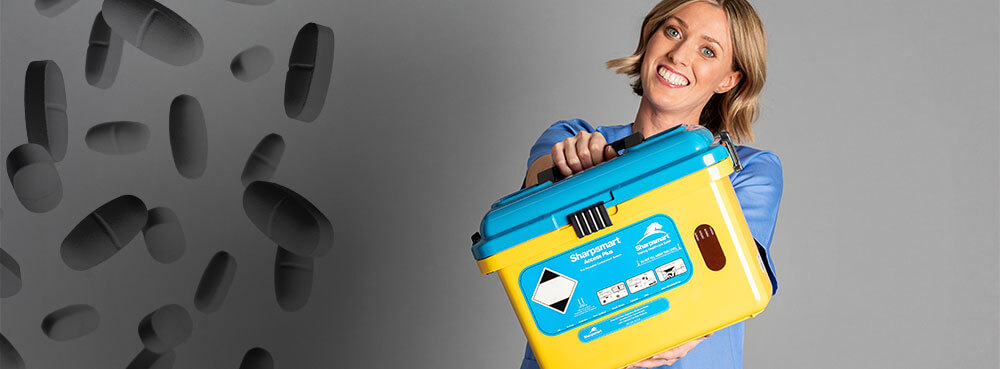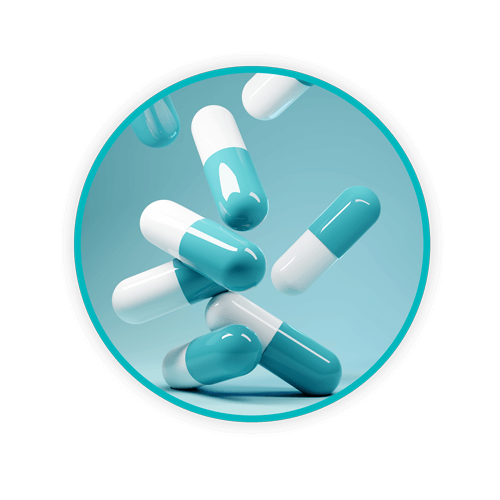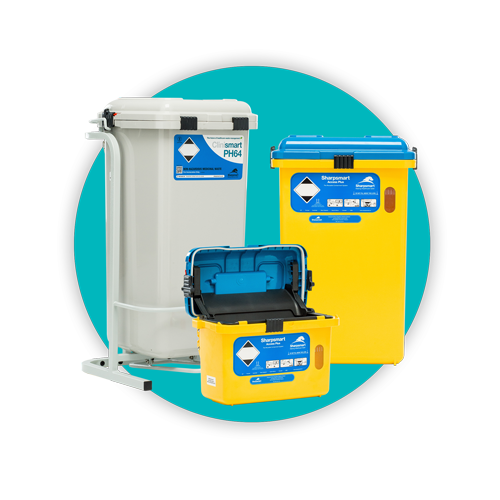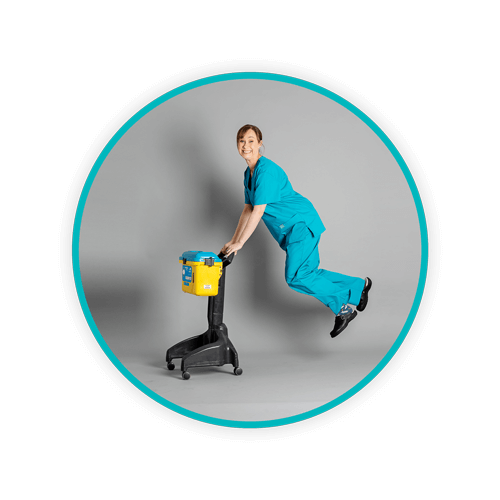What goes into a Pharmaceutical Waste Container?

Pharmaceutical waste is a component of medical waste management that is produced by a variety of healthcare scenarios: hospitals, care centres, clinics, veterinary facilities, community pharmacies, and even funeral homes. Pharmaceutical waste must be collected and disposed of properly to ensure safety not only to those handling such waste, but in regard to its disposal.
Knowing what goes into a pharmaceutical waste container and what doesn’t is the starting point for compliant pharmaceutical waste management.
TOPICS WE WILL COVER:
1 / What is pharmaceutical waste?
2 / What goes into a pharmaceutical waste container?
5 / Sharpsmart encourages compliant pharmaceutical disposal
What is pharmaceutical waste?
Definitions are important. The Health Technical Memorandum 07-01 defines a pharmaceutically active component as ‘medicines that may be nonhazardous or hazardous depending upon properties and include, but are not limited to, cytotoxic and cytostatic medical wastes (hazardous waste). Examples of a non-pharmaceutically active product includes saline and glucose.’
It’s also important to be aware that controlled drugs, due to their potential for harm, are subjected to special legislative controls throughout the UK. Refer to the Misuse of Drugs Regulations list to review medicines that have been classified as controlled drugs. Each schedule of such drugs (there are five) will determine the level of controls in regard to handling and disposal.
Non-hazardous clinical waste can include medicines other than those that are cytotoxic and cytostatic in nature. So too can sharps that are not contaminated with medicines or body fluids. Cytotoxic and cytostatic medicines, considered a type of clinical waste, are considered hazardous.
It’s also important to be aware, however, that a non-hazardous waste can be considered infectious for carriage transport in certain situations – for example, non-medicinally contaminated sharps.
Careful review is always required when it comes to pharmaceutical waste and how it is to be disposed of and the waste containers used in that disposal process. Processes that reduce pharmaceutical waste throughout the country are encouraged and can include a number of steps that also help to ensure safe and compliant pharmaceutical waste disposal.
According to a National Health Service publication focusing on care homes, pharmaceutical waste can include non-preventable waste, such as a case where patients no longer need medicines and portions of those medicines are no longer being used or in cases where medicines have expired. It is estimated that at the time of the publication (2015), roughly £50 million worth of medicines supplied by the National Health Service (NHS) are disposed of in care homes alone every year. Those numbers are expected to rise by 2025.[1]
As such, it is vital for every healthcare facility that handles, dispenses, or collects pharmaceuticals know which containers are to be used for disposal and what goes in them.
What goes into a pharmaceutical waste container?
Human and animal health care chemicals are defined as either hazardous or nonhazardous, and waste chemicals are not to be placed in offensive, mixed municipal, or clinical waste stream containers. However, some clinical waste streams might contain items that have been contaminated with chemicals such as those found in diagnostic kits, sharps, or other items contaminated with laboratory or therapeutic chemicals.
In such cases, the chemicals present, even in small quantities, should be identified by waste descriptions that are required in consignment notes for transportation. Waste medicines are typically classified as a cytotoxic or cytostatic medicine for waste classification if it contains any of the following characteristics:
- Toxic for reproduction
- Acutely toxic
- Mutagenic
- Carcinogenic
Cytotoxic and cytostatic medicines are included in the hazardous waste status, while other medicines are not. Cytotoxic and cytostatic medicines are to be disposed of in a purple-coloured container for incineration. Examples of cytotoxic drugs include cyclophosphamide, bleomycin, and busulfan. Examples of cytostatic drugs can include carmustine, chlormethine, and streptozocin.
Medicinally contaminated sharps (not with cytotoxic or cytostatic drugs) can be placed in yellow containers while sharps that are contaminated with cytotoxic and cytostatic medicines are placed into a yellow sharps box with a purple lid, intended for incineration only.
Cytotoxic and cytostatic medicines that are still in their original packaging are to be disposed of in rigid yellow containers with purple lids. In many scenarios, two containers will be made available, one for solid waste and one for liquid wastes. Cytotoxic and cytostatic medicines that are not in their original packaging are also contained in rigid yellow containers with purple lids.
Other medicines and pharmaceuticals, whether they are in their original packaging or not (but not cytotoxic or cytostatic) are to be disposed of in rigid yellow containers with blue lids.
A word about packaging and labelling
An important process of pharmaceutical waste management is not only the segregation of pharmaceutical waste, but in its containment/packaging and labelling, primarily for safety and to ensure that anyone handling that waste is aware of what the box, bag, or container has inside of it. This also ensures that it is appropriately disposed of.
As such, it is important to be aware of classification of waste medicines, which can be defined by either or both the chemical properties and/or their source.
Pharmacies handling or overseeing the use of controlled drugs must follow strict legislation of the:
- Misuse of Drugs Regulations
- Misuse of Drugs (Safe Custody) Regulations
- Controlled Drugs (Supervision of Management and Use) Regulations
Storage specifications and limitations of pharmaceuticals depends on the location of the drugs. For example, pharmacies must ensure that medicinal sharps waste is in secure containers, collected at a specific area, and that such waste has a flashpoint of less than 21°C, per the Health Technical Memorandum 07-01.
About waste transfer
Any healthcare facility looking to transport pharmaceutical waste off-site must also be aware of their legal responsibility in regard to documentation. Waste transfer documents may include consignment notes that are typically used for hazardous waste, and waste transfer notes that are used for nonhazardous waste.
All aspects of pharmaceutical waste management are the responsibility of not only community pharmacies, but health centres, general practices, dental practices, hospitals, and care homes. It is the duty of care of any entity dealing with pharmaceutical products or wastes to ensure compliance not only to prevent fines and penalties, but to protect healthcare providers, patients, and the environment from accidental exposure.

Sharpsmart encourages compliant pharmaceutical waste management processes
Sharpsmart promotes and encourages compliance with every aspect of pharmaceutical waste management, from segregation at its point of origin to its ultimate disposal. For guidance or information regarding up-to-date regulations in pharmaceutical waste, or placement of compliant pharmaceutical waste containers, transportation, or disposal of such, contact us today.
Let's Talk!
Your time is valuable, and we don’t want to play hard to get. You can either phone us directly on the details listed on our contact page, or feel free to fill out this short form and one of our team members will get back to you as quickly as possible.
